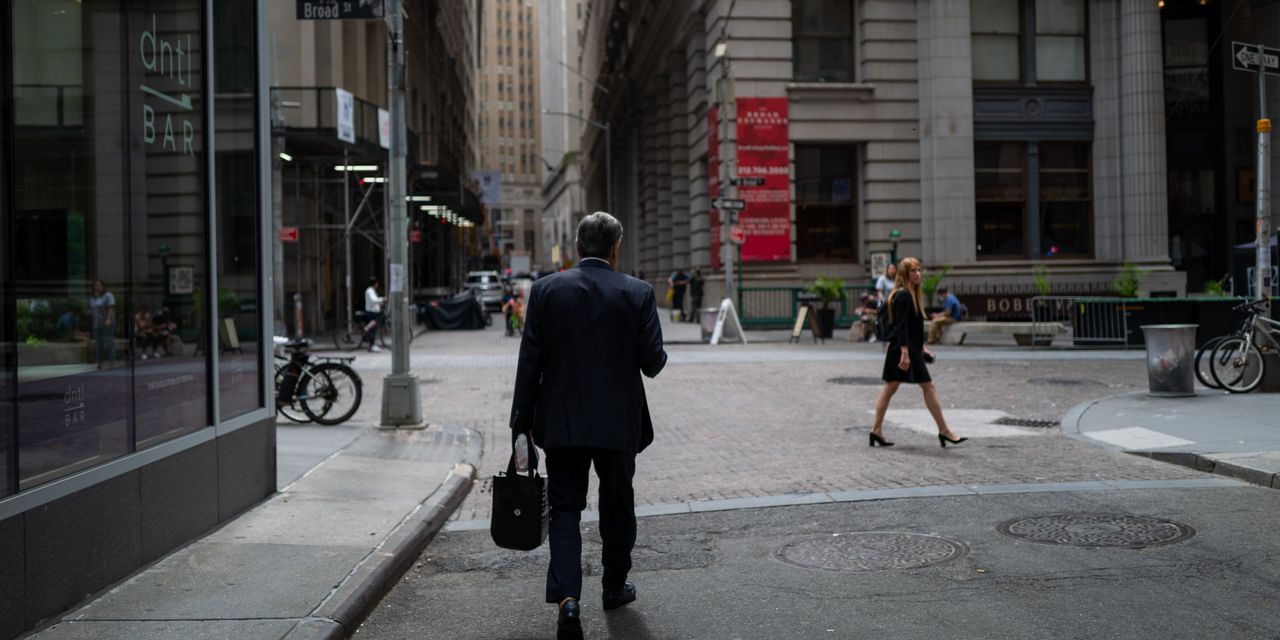For a sixth straight trading session, the U.S. bond market sent out one of its most reliable recession signals as the 2-year rate continued to trade above its 10-year counterpart and the spread between the two yields deepened further below zero.
On Tuesday, the 2s10s spread shrank to its narrowest level in more than 15 years, dropping to as low as minus 13.1 basis points. The current round of 2s10s inversion began on July 5, after investors returned from the Fourth of July holiday, and Tuesday’s action pointed to a worsening long-term outlook, as reflected in a 10-year rate
TMUBMUSD10Y,
below 2.92%.
Concerns about the path of the economy are persisting in the bond market as investors continue to flock to the safety of government debt, driving most yields lower while stocks
DJIA,
COMP,
were higher in late-morning trading. Yield curve inversions have typically preceded every recession since the 1950s, albeit with a lag that could take anywhere from months to a few years. Analysts disagree, however, on whether the 2s10s spread is the best part of the Treasury curve to look at and some even dismissed its brief inversion earlier this year.
“We think it is a mistake to discount the curve inversion,” BofA Securities rates strategist Bruno Braizinha wrote in an email to MarketWatch on Tuesday. “We continue to expect the curve to be under flattening pressure near-term, but see a smaller degree of inversion by year-end, around -25bp for 2s10s UST” versus the minus 50 basis point inversion he and his colleagues foresaw in April.
“The inversion is driven both by a relatively sticky Fed pricing at the front end (given the inflation backdrop) and downside risks to growth that are starting to weigh on yields at the back end of the curve, as Treasuries also regain their utility as a portfolio hedge,” he said.
Sentiment has darkened among some investors as they brace for the next major U.S. inflation update on Wednesday, with the release of the consumer-price index report for June. Forecasters expect that report to show an annual headline inflation rate of 8.8%, up from 8.6% in May, which will likely set the tone for the Fed’s next meeting on July 26-27.
Last Friday’s U.S. nonfarm payrolls report for June, which showed 372,000 new jobs created, helped allay fears that a downturn is on the way because the National Bureau of Economic Research, the official arbiter of U.S. business cycles, defines a recession as “a significant decline in economic activity that is spread across the economy and that lasts more than a few months.”
Yet in a roundabout way, markets have interpreted the labor market’s strength as a reason why the Fed can focus solely on its inflation fight, by hiking rates aggressively even if it means sending the U.S. into a recession.
Fed-funds futures traders see a 93% likelihood that policy makers will deliver a 75 basis point rate increase in two weeks, and a 7% chance that the hike could be as big as 100 basis points. The fed-funds rate target currently sits between 1.5% and 1.75%, after Fed officials hiked by three-quarters of a percentage point in June following May’s disappointing CPI data, which indicated inflation had yet to peak.
Read: Robust U.S. jobs data open door to outside risk of full-percentage-point Fed rate hike this month
The length of the current 2s10s inversion “now puts it ahead of the 3-day inversion back in late-March/early April, so this is getting harder to dismiss as just a blip,” Deutsche Bank’s Jim Reid, Henry Allen and Tim Wessel wrote in a note. They also point out that the Fed’s own preferred yield curve indicator has shrunk dramatically since April.
Even so, some analysts said the inversion reflects ongoing uncertainty around the economy’s most likely path forward.
“On one hand, you have many economists that say the U.S. economy is already in a recession, and half of Americans thought we were in a recession as of mid-June,” said Marc Chandler, managing director and chief market strategist at Bannockburn Global Forex. “On the other hand, the Federal Reserve is pushing back on that. I’m in the middle of those two camps, with the view that the economy is likely slowing down but we’re not in a recession yet. I think it comes late this year or early next year.”
“The inversion of the curve is pointing to uncertainty around the outlook for the U.S. economy,” Chandler said via phone. He noted the Atlanta Fed’s GDP Now model estimates real GDP growth contracted by minus 1.2% in the second quarter, but a Bloomberg survey of about 60 professional forecasters shows that only one of them thinks there was a second-quarter contraction.

